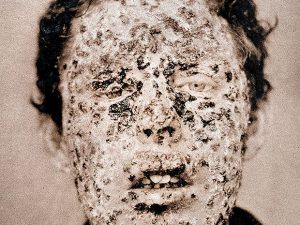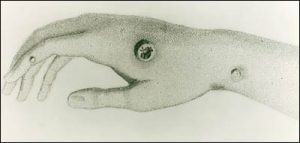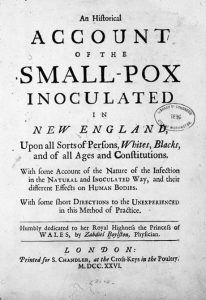African Discovery vs Colonial Anti-Vaxxers Earthdate 2017.309
Have you guys heard about how vaccination was “first discovered”? About the Englishman, Edward Jenner who used the fact that milk-maids, the women who milked the cows didn’t seem to ever get smallpox – hence the saying, “Like a milkmaid’s skin”? That’s the story I knew, but it turns out he wasn’t the first to figure this out. Inoculation had been practiced in West Africa for hundreds of years before Jenner-baby ever thought of it. African doctors would take a small bit of infectious material from one person, and scratch it into another with a thorn. They understood that this would protect the recipient from the full-blown, and deadly disease. Smallpox killed 20-80% of those who got it, changing the course of history and nations; a likely factor in the fall of the Roman Empire. It was the most common cause of blindness, and could leave survivors with all sorts of problems, not to mention the horrendous scarring.

Smallpox Victim, NYC 1881
The African medics were likely working on the well-known fact (since 430 BC) that smallpox survivors never seemed to get it again. They took this to the next level, by developing inoculation, also called variolation. It was introduced to the global north during the 1721 Boston smallpox epidemic. But the African origins of inoculation are typically not noted in immunology texts. Instead, it’s Edward Jenner who’s called “the father of immunology” and is given sole credit for this world-changing discovery. But like most truths, the real story is more complicated and more interesting.

Variolation is an early form of vaccination developed in West Africa, China and elsewhere starting in the 15th c. A a small amount of infectious material is purposefully scratched into the skin, promoting immunity.
In 1706, Cotton Mather, a highly placed minister, documented racist, and prolific writer, asked the enslaved African, Onesimus if he’d ever had smallpox before assigning him to work in his home. Asking enslaved workers about their smallpox history was standard practice before assigning them to work inside the slave owners’ homes. Didn’t want to expose family to smallpox, and everyone knew if you’d survived you wouldn’t be getting it again. But, Onesimus’s answer, “Yes and no” stumped Mather at first. Onesimus (the name Mather gave him) explained the practice of inoculation, hence “yes” he had been infected, but “no” he never had the disease. (Yes, the hypocrisy is neon-lit, that this “Christian” minister accepted the “gift” of an enslaved African, and all during a time when American colonists were arguing that England was enslaving America by not granting its independence. Yet, Mather was also able to hear what Onesimus was telling him, and recognise its importance.)
Mather, who almost pursued a career in medicine, avidly read all the latest publications. He went around Boston to ask other slaves if they’d had the same sort variolation. Many of them did, and it turned out that slaves with the tell-tale scar on their arm fetched a higher price. In 1714 Mather published an essay in the London’s Royal Society’s Philosophical Transactions, including quoting Onesimus in his accent, “People take Juice of Small-Pox; and Cutty-skin, and Putt in a Drop.” As the first American -born fellow of the London’s Royal Society, that was headed by Isaac Newton at the time, Mather was eager to raise the stature of Boston (and himself) in the eyes of European intellectuals. Fighting smallpox and other infectious disease was a hot topic in the early 18th century but, nothing much more happened. Not yet, anyway.

On 22 April 1721, fifteen years after Mather learned about inoculation from Onesimus, the HMS Seahorse, sailed in from the West Indies and docked in Boston Harbour. There was smallpox on the ship, and despite taking all the precautions available at that time, an epidemic broke out, eventually infecting roughly half of Boston’s 12,000 inhabitants. Mather quickly published an “Address to the Physicians of Boston” calling on them to use inoculation to save lives. Only one person responded favourably, Zabadiel Boylston, alternately described as a doctor or an apothecary. (Boylston also turned out to be the future President John Adams’s great-uncle.) Zabadiel Boylston inoculated his six-year-old son and two enslaved Africans, and announced their successful inoculation on 15 July 1721.

Other area doctors and councilmen were horrified. Despite everyone knowing that surviving the disease resulted in future immunity with survivors even called upon to care for infected people, the idea of purposefully infecting people was just too weird for Americans and Europeans. Anti-inoculators, colonial anti-vaxxers, rose up in droves. They considered this variolation to be a form of terrorism as if “a man should wilfully throw a Bomb into a Town.” They embraced conspiracy theories too (sound familiar?), including that inoculation was really an effort on the part of enslaved Africans to kill White folks. One anti-vaxxer (of 1721, I’m not suggesting current ones time-travel) threw a grenade through Mather’s window with a note, “COTTON MATHER, You Dog, Dam You; I’l inoculate you with this, with a Pox to you.”
Personality comes into it, too. Mather was an arrogant prig who had been involved in the Salem witch hunts of 1692. A self-righteous, fifty-eight-year-old, blow-hard was easy pickings for the brand new Bostonian satirical newspaper, The New-England Courant. The newspaper’s editor, James Franklin was none other than Benjamin Franklin’s apparently somewhat less clever older brother. And as yet another interesting aside, Ben was an indentured servant to his older brother James. The Courant debuted in August 1721 and jumped right into the inoculation debate, deriding Mather and his newest idea, chalking it up as nothing more than another attempt at self-aggrandizement.
But to their credit, Mather and Boylston soldiered on with their inoculation campaign to “Conquer the Dragon”. It’s good to know even annoying blowhards can do good. By the time the epidemic had run its course, the data were in, and they were striking. Of the approximately 6,000 who contracted the disease, those who were not inoculated had a 14% chance of dying. But only 2% of the roughly 600 Bostonians who had been inoculated died.
Mather and Boylston were initially recognised for their important work with Boylston travelling to London for a time. Onesimus bought his freedom, with little else known about the rest of his life, besides the fact that he had a wife and a son who died. More smallpox epidemics ensued, with about 400,000 dying each year. Variolation was the best defence until the safer vaccine was developed from cowpox by Edward Jenner, in 1796. It took almost another 200 years before The World Health Organisation declared smallpox eradicated in 1979. This world-wide victory came about through the cross-fertilisation of ideas and opportunities, across cultures and continents. The report by an enslaved African to his owner, who was able to see beyond his own racism in this instance. Here’s to Onesimus, whose real name is lost, and the African doctors who developed variolation, finding their way into all immunology textbooks.
Further reading:
https://www.history.com/news/smallpox-vaccine-onesimus-slave-cotton-mather
https://www.the-scientist.com/foundations/introducing-inoculation-1721-68275
